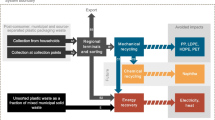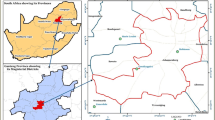Abstract
This study analyses the packaging waste management system in Belgium. Waste management operations involve a significant number of processes associated with energy consumption and emission of pollutants in air and water. To assess the impact on the environment of the several waste management operations, a life cycle assessment was developed. The operations of selective and refuse collection, sorting, recycling and incineration of packaging waste were considered. A comparison between two scenarios was developed. The first scenario comprised the packaging waste management system in operation in 2010. This system comprises the waste management operations envisaging the recycling of the packaging materials. The second scenario was developed based on the hypothesis that there was no recycling system and all packaging waste would be collected in the refuse collection system. An environmental valuation was performed to convert the environmental results into a common unit (EUR). To accomplish this valuation, three methods were used: Ecocost, Ecovalue and Stepwise. These methods were developed in Europe and follow different methodologies. The environmental results were compared using the three methods and they were consistent with the conclusion that the recycling scenario (i.e. the actual situation in 2010) is more environmentally sound.




Similar content being viewed by others
Notes
Printed paper is collected together with packaging paper.
References
Rigamonti L, Grosso M, Giugliano M (2009) Life cycle assessment for optimising the level of separated collection in integrated MSW management systems. Waste Manag 29:934–944
Eriksson O, Carlsson RM, Frostell B, Björklund A, Assefa G, Sundqvist JO, Granath J, Baky A, Thyselius L (2005) Municipal solid waste management from a system perspective. J Clean Prod 13:241–252
Cherubini F, Bargigli S, Ulgiati S (2009) Life cycle assessment LCA of waste management strategies: landfilling, sorting plant and incineration. Energy 34:2116–2123
Giugliano M, Cernuschi S, Grosso M, Rigamonti L (2011) Material and energy recovery in integrated waste management systems. An evaluation based on life cycle assessment. Waste Manag 31:2090–2101
Massarutto A, Carli A, Graffi M (2011) Material and energy recovery in integrated waste management systems: a life-cycle costing approach. Waste Manag 31:2102–2111
Wada Y, Okumoto T, Wada N (2008) Evaluating waste disposal systems. J Mater Cycles Waste 10:173–187
Fost Plus (2013) Intermunicipal authorities. The complete list. http://www.fostplus.be/SiteCollectionDocuments/Werking%20Fost%20Plus%20en%20partners/Inzamelen/Intercommunales_2013.htm. Accessed 27 Dec 2013
Eurostat (2015) Statistics. Database. Environment. http://ec.europa.eu/eurostat/data/database. Accessed 05 Feb 2015
OVAM (2012), publieke lijsten (public lists). http://www.ovam.be/webtoepassingen-en-publieke-lijsten. Accessed 05 July 2012
Wallonie (2015), Direction des Infrastructures de Gestion des Déchets. Statistiques. http://environnement.wallonie.be/cgi/dgrne/plateforme_dgrne/visiteur/v2/frameset.cfm?page=http://environnement.wallonie.be/administration/dsd.htm. Accessed 05 Feb 2015
Brussel L (2015), Documentatie and Kaarten (documents and maps). http://www.leefmilieu.brussels/doc. Accessed Feb 2015
EIMPack (2013) The economics of the recycling of packaging waste: the case of Belgium. Economic impact of the packaging and packaging waste directive. Instituto Superior Técnico, Lisbon
International Organization for Standardization (ISO) (2006) ISO 14040 international standard. In: Environmental management—life cycle assessment—principles and framework. ISO, Geneva, Switzerland
Clift R, Doig A, Finnveden G (2000) The application of life cycle assessment to integrated solid waste management. Part 1: methodology. Process Saf Environ 78:279–287
EEA (2012) EMEP/EEA emission inventory guidebook 2009, updated May 2012. European Environment Agency
Pulles T, Denier van der Gon H, Appelman W, Verheul M (2012) Emission factors for heavy metals from diesel and petrol used in European vehicles. Atmos Environ 61:641–651
EEA (2007) EMEP/CORINAIR emission inventory guidebook—2007. Technical Report No 16/2007. European Environment Agency
Spielmann M, Dones R, Bauer C (2007) Life cycle inventories of transport services. Final report ecoinvent data v2.0, vol 14. Swiss Centre for Life Cycle Inventories, Dübendorf, Villigen, Switzerland
FostPlus (2014). http://www.fostplus.be/Documentation/annualreport/Pages/Annualreport2010.aspx#sub42. Accessed 1 July 2014
Margallo M, Aldaco R, Bala A, Fullana P, Irabien A (2013) Modeling of municipal solid waste (MSW) Incineration in Spain and Portugal. The 6th international conference on life cycle management in Gothenburg, Nebraska, USA
Sabin Guendehou GH, Koch M, Hockstad L, Pipatti R, Yamada M (2006) Incineration and open burning of waste, Chapter 5. In: 2006 IPCC Guidelines for national greenhouse gas inventories, vol. 5. Intergovernmental Panel on Climate Change (IPCC) National Greenhouse Gas Inventories Programme, Geneva, Switzerland, p 5.5. http://www.ipcc-nggip.iges.or.jp/public/2006gl/pdf/5_Volume5/V5_5_Ch5_IOB.pdf
Blanco MM (2012) FENIX—giving packaging a new life waste incineration in Spain and Portugal: a multi-input/multi-output allocation model. Department of Chemical Engineering and Inorganic Chemical, Cantabria University. Paper presented at the meeting “Avances metodológicos en el Análisis de Ciclo de Vida (ACV) de gestión de residuos: Proyecto FENIX”, Lisbon, Portugal
IPCC (2006). Guidelines for National Greenhouse Gas Inventories. Chapter 2. Waste generation, composition and management data, vol. 5, Intergovernmental Panel on Climate Change (IPCC), Geneva, Switzerland
Reinhart (2004). Estimation of energy content of municipal solid waste. http://msw.cecs.ucf.edu/EnergyProblem.pdf. Accessed 05 June 2013
Arena U, Mastellone ML, Perugini F (2003) Life cycle assessment of a plastic packaging recycling system. Int J Life Cycle Assess 8:92–98
Nakamura S, Kondo Y (2002) Recycling, landfill consumption, and CO2 emission: analysis by waste input–output model. J Mater Cycles Waste 4:2–11
Spitzley J-B, Najdawi C (2011) Integration of electricity from renewables to the electricity grid and to the electricity market—RES-INTEGRATION. National report: Belgium (and Flanders and Walloon Regions). Eclareon and Institute for Applied Ecology, Berlin, Germany
Eurostat (2013a). Imports (by country of origin)—electricity—annual data. http://appsso.eurostat.ec.europa.eu/. Accessed 26 Dec 2013
Eurostat (2013b) Statistics. Main tables. Energy. http://epp.eurostat.ec.europa.eu/portal/page/portal/energy/data/main_tables. Accessed 26 Dec 2013
Vogtländer JG, Brezet HC, Hendriks CF (2001) The virtual eco-costs 99—a single LCA-based indicator for sustainability and the eco-costs—value ratio (EVR) model for economic allocation. A new LCA-based calculation model to determine the sustainability of products and services. Int J Life Cycle Assess 6:157–166
TU Delft (2013) The model of the eco-costs/value ratio (EVR). Delft University of Technology, The Netherlands. http://www.ecocostvalue.com. Accessed 1 July 2013
Weidema BP (2013) Impact assessment with option of full monetarisation. http://www.lca-net.com/projects/Stepwise2006_ia. Accessed 1 July 2013
Ahlroth S, Finnveden G (2011) Ecovalue08—a new valuation set for environmental systems analysis tools. J Clean Prod 19:1994–2003
Eurostat (2013c). HICP–inflation rate. Annual average rate of change (%). http://epp.eurostat.ec.europa.eu/tgm/table.do;jsessionid=9ea7d07d30e7e84a2aa50db743a19f49c1b10583cf2d.e34OaN8PchaTby0Lc3aNchuMc3yMe0?tab=table&plugin=1&language=en&pcode=tec00118. Accessed 30 Dec 2013
Acknowledgments
This paper had the financial support of the European Investment Bank University Research Sponsorship (EIBURS) Program. The findings, interpretation and conclusions presented in this article are entirely those of the authors and should not be attributed in any manner to the EIB.
Author information
Authors and Affiliations
Corresponding author
Rights and permissions
About this article
Cite this article
Ferreira, S., Cabral, M., De Jaeger, S. et al. Life cycle assessment and valuation of the packaging waste recycling system in Belgium. J Mater Cycles Waste Manag 19, 144–154 (2017). https://doi.org/10.1007/s10163-015-0383-x
Received:
Accepted:
Published:
Issue Date:
DOI: https://doi.org/10.1007/s10163-015-0383-x




